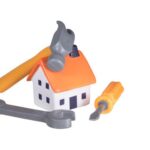Are you considering making some updates to your home but don’t have the funds readily available? A home improvement loan might be the solution for you. In this article, we will guide you through the process of applying for a home improvement loan, from understanding the different types of loans available to tips for a successful application.
When it comes to making improvements to your home, whether it’s renovating the kitchen, adding a new bathroom, or installing energy-efficient appliances, a home improvement loan can provide the financial assistance you need. Understanding how to apply for a home improvement loan is crucial in ensuring that your project gets off the ground.
Before diving into the application process, it’s important to assess your financial situation and determine how much you will need to borrow for your home improvement project. Once you have a clear understanding of your needs, researching lenders and loan options will be essential in finding the best fit for your financial situation. Gathering necessary documents and information and completing the application process are key steps in securing a home improvement loan.
Understanding what to expect during the approval process is also important in managing expectations. With proper planning and preparation, applying for a home improvement loan can be a smooth and successful experience.
Understanding the Different Types of Home Improvement Loans
When it comes to applying for a home improvement loan, it’s important to understand the different types of loans available to you. Each type of loan has its own set of requirements, terms, and benefits, so it’s crucial to choose the one that best fits your financial situation and home improvement needs.
Secured vs. Unsecured Loans
One of the main distinctions between home improvement loans is whether they are secured or unsecured. Secured loans require collateral, such as your home or another valuable asset, while unsecured loans do not. Secured loans typically have lower interest rates and higher borrowing limits, but they also come with the risk of losing your collateral if you default on the loan.
Personal Loans vs. Home Equity Loans/HELOCs
Personal loans are unsecured loans that can be used for a variety of purposes, including home improvements. They have fixed interest rates and repayment terms, making it easier to budget for monthly payments. On the other hand, home equity loans and home equity lines of credit (HELOCs) are secured by your home’s equity and typically offer lower interest rates but require you to use your home as collateral.
Government-Backed Loans
There are also government-backed loan programs specifically designed for home improvements, such as FHA Title 1 loans and Energy Efficient Mortgages (EEMs). These programs may offer lower interest rates and more lenient eligibility requirements for homeowners looking to make energy-efficient upgrades or essential repairs.
Understanding the different types of home improvement loans is essential in determining which option best suits your needs and financial situation. By familiarizing yourself with these options, you can make an informed decision when applying for a loan that will help turn your renovation dreams into reality.
Assessing Your Financial Situation and Determining the Loan Amount
Understanding Your Current Financial Position
Before applying for a home improvement loan, it’s crucial to assess your current financial situation. This involves taking a close look at your income, expenses, savings, and any existing debts. Understanding your monthly cash flow and overall financial health will help you determine how much you can realistically afford to borrow for your home improvement project.
Evaluating the Cost of Your Home Improvement Project
Once you have a clear picture of your financial situation, the next step is to determine the total cost of your home improvement project. Whether it’s a kitchen renovation, bathroom remodel, or new roof installation, it’s important to get accurate cost estimates from contractors or suppliers. Take into account all potential expenses including materials, labor, permits, and any unforeseen costs that may arise during the project.
Determining the Loan Amount
After evaluating the cost of your home improvement project and assessing your financial capabilities, you can now determine the loan amount you need to borrow. It’s essential to strike a balance between borrowing enough to cover your project’s costs while ensuring that you can comfortably make the monthly loan payments. Consider factors such as interest rates, repayment terms, and future financial goals when deciding on the loan amount.
By thoroughly assessing your financial situation and accurately determining the loan amount needed for your home improvement project, you’ll be better equipped to apply for a home improvement loan with confidence. Engaging in this careful planning process will increase your chances of securing a loan that meets your needs without causing undue financial strain.
Researching Lenders and Loan Options
As you start the process of applying for a home improvement loan, it’s important to research different lenders and loan options to ensure that you are getting the best deal for your specific needs. There are many lenders, including banks, credit unions, and online lenders, who offer home improvement loans. Each lender may have different eligibility requirements, interest rates, and terms, so it’s crucial to compare multiple options before making a decision.
When researching lenders and loan options, consider factors such as the interest rate, loan term, fees, repayment options, and customer reviews. You can use online comparison tools and visit the websites of various lenders to gather information about their home improvement loan products. Additionally, don’t hesitate to reach out to lenders directly to ask any questions you may have about their loans and the application process.
It’s also essential to consider the type of home improvement project you are planning to undertake when researching lenders and loan options. Some lenders may specialize in certain types of projects or offer specific loan products designed for renovations, repairs, or energy-efficient upgrades. By identifying a lender that caters specifically to your project needs, you may be able to find a more tailored and beneficial loan option.
| Factor | Consideration |
|---|---|
| Interest Rate | Compare rates from different lenders |
| Fees | Research any associated fees with each lender |
| Repayment Options | Understand the available repayment plans offered by each lender |
Gathering Necessary Documents and Information
Before applying for a home improvement loan, it is crucial to gather all necessary documents and information that lenders will require during the application process. This step is essential to ensure a smooth and efficient loan application process. The required documents may vary depending on the lender and the type of loan you are applying for, but generally, you will need to provide proof of income, employment verification, credit history, and property information.
One of the most important documents you will need to provide is proof of income, which can include pay stubs, W-2 forms, tax returns, or bank statements. Lenders use this information to assess your ability to repay the loan. Additionally, you will need to verify your employment status, so be prepared to provide contact information for your employer.
Another crucial aspect of applying for a home improvement loan is your credit history. Lenders will review your credit score and history to determine your creditworthiness. It is important to review your credit report before applying for a loan to identify any potential issues that could impact your eligibility.
In addition to financial documentation, you will also need to provide information about the property you are seeking to improve. This may include property assessments, estimates from contractors or home improvement professionals, and details about the scope of work. Providing comprehensive information about the project will help lenders understand the purpose of the loan and how it will be used.
Overall, gathering necessary documents and information is a critical step in the home improvement loan application process. By being thorough and organized in preparing these materials, you can demonstrate your readiness and responsibility as a borrower. Taking the time to gather these documents upfront can expedite the application process and increase your chances of securing a favorable loan for your home improvement project.
Completing the Loan Application Process
Once you have identified the type of home improvement loan that best suits your needs and have researched potential lenders, the next step is to complete the loan application process. This is a crucial stage in securing the necessary funds to carry out your renovation or remodeling project. Here are the steps to take when completing the home improvement loan application:
- Reviewing Application Requirements: Before filling out the application, carefully review the lender’s requirements and guidelines. Make sure you have all the necessary documents and information readily available.
- Gathering Required Documents: Gather documents such as proof of income, employment verification, credit history, property information, and any other documentation required by the lender. Organize these documents to streamline the application process.
- Filling Out the Application: Take your time to accurately fill out the loan application form. Provide all requested information truthfully and completely. Ensure that there are no errors or omissions that could delay the processing of your application.
It is important to note that different lenders may have varying application processes and requirements, so it is essential to carefully follow their specific instructions for submitting a home improvement loan application.
Overall, understanding how to apply for a home improvement loan involves thorough preparation and attention to detail throughout each step of the process. By being proactive in gathering necessary documents and providing accurate information on your application, you can increase your chances of a successful loan approval and ultimately realize your home improvement goals.
What to Expect During the Loan Approval Process
Once you have completed the application process for a home improvement loan, the next step is to wait for the loan approval process. Here’s what you can expect during this stage:
During the loan approval process, the lender will review your application and determine whether you meet their eligibility criteria. This may include factors such as your credit score, income, employment history, and debt-to-income ratio. Here’s a breakdown of what typically happens during the loan approval process:
1. Underwriting: Once you have submitted your application, the lender will start the underwriting process. This involves a thorough review of your financial situation and creditworthiness. The lender may request additional documentation or information during this stage.
2. Property Appraisal: In some cases, the lender may require a professional appraisal of your property to determine its current value. This is especially common for home equity loans or lines of credit.
3. Conditional Approval: If everything looks good on paper, you may receive a conditional approval from the lender. This means that you are approved for the loan pending certain conditions, such as providing additional documentation or clarification on certain aspects of your application.
4. Final Approval and Closing: Once all conditions have been met, the lender will issue a final approval for your loan. You will then proceed to closing, where you will sign the necessary paperwork and receive funding for your home improvement project.
It’s important to note that the timeline for loan approval can vary depending on the lender and your individual circumstances. Some lenders may offer expedited approval processes, while others may take longer to review and approve your application.
Overall, understanding what to expect during the loan approval process can help you be better prepared and manage your expectations as you await a decision.
Remember that each lender has different requirements about how to apply for home improvement loans so it’s important to understand these details before submitting an application.
Tips for a Successful Home Improvement Loan Application
When it comes to applying for a home improvement loan, proper planning and preparation are key to increasing your chances of success. Here are some tips to help you navigate the application process and secure the funds you need for your home renovation projects.
First and foremost, it’s important to assess your current financial situation and determine the amount of loan you will need. Take stock of your income, expenses, and existing debts to understand how much you can comfortably afford to borrow. This will also help you narrow down the type of home improvement loan that best suits your needs, whether it’s a personal loan, home equity loan, or home equity line of credit.
Next, research lenders and loan options to find the best fit for your specific circumstances. Compare interest rates, terms, and fees from different financial institutions to ensure you’re getting the most favorable deal possible. Keep in mind that some lenders specialize in home improvement loans and may offer unique products tailored to these types of projects.
Gathering necessary documents and information is another crucial step in the application process. Be prepared to provide proof of income, tax returns, bank statements, as well as details about the renovation project itself. Having all these documents organized and readily available will streamline the application process and demonstrate to lenders that you are a responsible borrower. Following these tips can ultimately make all the difference in securing a successful home improvement loan application.
Conclusion
In conclusion, applying for a home improvement loan requires careful planning and preparation. It’s important to start by assessing your financial situation and determining the amount of loan you will need for your project. Understanding the different types of home improvement loans and researching lenders will help you find the best option for your needs. Gathering all necessary documents and information ahead of time will streamline the application process, making it easier for both you and the lender.
Additionally, completing the application process with attention to detail will increase your chances of approval. Being prepared for what to expect during the approval process can alleviate some of the stress associated with obtaining a loan. Overall, taking the time to plan and prepare will set you up for success in securing a home improvement loan.
Remember, proper planning and preparation is key when applying for a home improvement loan. By following the steps outlined in this article, you can increase your chances of a successful application. So, before embarking on your next home improvement project, take the time to research, gather documents, and understand the various loan options available to you. With careful consideration and attention to detail, you can confidently apply for a home improvement loan that meets your needs.
Frequently Asked Questions
What Is the Minimum Credit Score for a Home Improvement Loan?
The minimum credit score for a home improvement loan can vary depending on the lender, but generally, a score of 620 or higher is recommended. A higher credit score may result in better loan terms and interest rates.
What Is the Typical Term for a Home Improvement Loan?
The typical term for a home improvement loan is anywhere from 5 to 20 years. However, some lenders may offer shorter or longer terms depending on the borrower’s needs and financial situation.
What Is the Difference Between a Home Loan and a Home Improvement Loan?
The main difference between a home loan and a home improvement loan is their intended purpose. A home loan, often referred to as a mortgage, is used to purchase or refinance a home, while a home improvement loan is specifically for renovating or making repairs to an existing property. Additionally, the application process and requirements for these loans may differ.

I’m thrilled to have you here as a part of the Remodeling Top community. This is where my journey as an architect and remodeling enthusiast intersects with your passion for transforming houses into dream homes.





